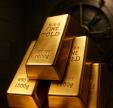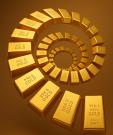Japan Between A Rock And A Hard Spot Part - I
"Only Solution Is To Dump U.S. Treasuries and Buy GOLD!"
PART - I
Introduction -
The T-Bomb detonated on June 23, 1997 at Columbia University by Japan's Prime Minster, Ryutaro Hashimoto, has motivated me to 'rehash' a series I started many months ago - when conventional wisdom felt it was an absurd idea to think the Land of the Rising Sun would dare unload it burgeoning burden of U.S. T-Bonds, INDEED even contemplate the 'ridiculous' notion. However, Mr. Hashimoto has dispelled all these naive and credulous opinions, when he publicly and candidly confessed:
"I hope the U.S. will engage in efforts and in cooperation to maintain exchange stability so we will not succumb to the temptation to sell off Treasury bills and switch our funds to gold,..."
"We were tempted to sell off... It is true we have not really made the advantageous choice."
"I believe the U.S. economy has the strength to absorb (a bond sell off) "but the effects could be enormous. ... It is because ... countries are holding onto the T-bills that the U.S. economy is being maintained."
"I hope the United States may engage in efforts to maintain exchange stability."
Demographics -
In order to put this report's conclusions into proper perspective, it is necessary to understand the relative demographics of Japan vis-a-vis well-known geographic areas.
| Country | Area (square miles) | Pop (millions) | Capita/Density |
| Brazil | 3,287,000 | 135,000,000 | 41/Sq Mile |
| U.S.A | 3,022,000 | 265,000,000 | 88/Sq Mile |
| Argentina | 1,082,000 | 35,000,000 | 32/Sq Mile |
| State of Montana | 147,000 | 1,500,000 | 10/Sq Mile |
| JAPAN | 142,000 | 130,000,000 | 915/Sq Mile |
Here are some meaningful comparisons. Brazil has about the same size population as Japan, but has more than 23 TIMES THE LAND MASS FROM WHICH TO FEED ITS POPULATION. Although the USA population is twice that of Japan, America has more than 21 TIMES THE LAND MASS FROM WHICH TO FEED ITS POPULATION. Argentina has almost 100,000,000 LESS population, but the "Gauchos" have 7.6 TIMES THE LAND MASS....Even the state of Montana has a much easier task in feeding its population - although Montana has an equal land mass, IT HAS ONLY ONE PERCENT OF THE POPULATION OF THE LAND OF THE RISING SUN. It is painfully clear Japan has a tough row to hoe in feeding its hard-working and very industrious people.
It is a little known fact that Japan is the world's largest importer of food. To a great extend Japan's very survival is a function of its hard currency foreign reserves and the prevailing rate of inflation of commodity foodstuffs and energy.
Perhaps the most startling demographic statistic refers to population density. Consider the following amazing population density data (persons per square mile): Brazil 41; USA 88; Argentina 32; Montana 10; AND JAPAN 915 PEOPLE PER SQUARE MILE! This fact must provoke serious thought. JAPAN HAS INDEED DIRE NEEDS.
Need for Hard Currency -
The ability to ensure Japan has an adequate inflow of foreign currency is a function of its industries' ability to export manufactured products. Their success in this endeavor during the last 35 years is legendary. However, all good things come to an end. From 1985 through 1995 Japanese manufactured exports have rapidly lost a great deal of their competitive edge. This loss is mostly attributed to incredible appreciation of the Yen versus all currencies - especially the US dollar. In protection of Japan's survival policy, its government has taken action to correct a deteriorating situation. Through a concerted effort of Japan's central bank, Bank of Japan (BOJ), the Yen trend against the dollar reversed downward last year after repeated greenback support efforts were made by the BOJ. The BOJ has on numerous occasions had to spend tens of billions of dollars in purchasing the greenbacks -- which in essence is shorting its own currency.
In recent months however, the Yen has risen nearly 10% in value versus the dollar. Therefore, in order to protect its export business (source flow of hard currencies) the BOJ is forced to continue its costly monetary battle to support the dollar. Ergo, Mr. Hashimoto's well-planned and totally intentional outburst that "I hope the United States may engage in efforts to maintain exchange stability."
Need to Reflate Economy -
Unfortunately, Japan has another acutely serious economic problem. In an effort to reflate its economy the BOJ has employed a solution which rests on the abolition of interest rates. Yen interest rates have been forcibly kept low for some time. Testament to the BOJ exaggerated easing policy is their 10-year Yen denominated bond yielding less than 2.5%. BOJ's low interest rate maintenance policy has two economic benefits for their economy: economic reflation and weakening the Yen versus the dollar.
While all this has been going on, the U.S. government has been financing its growing National Debt via the sale of Treasury bonds to international institutions. In the past 12 months foreign central banks have accumulated $545 billion of US Treasuries - with more than $200 billion in greenback paper going to the BOJ. For numerous reasons this has become an aggravating and seemingly unending problem for the Japanese.
Need for Reserves Diversification -
The preponderance of the BOJ's international reserves are U.S. dollars. In the strict risk diversification policies of any central bank, this is a decidedly financially dangerous posture. The 12% drop in the U.S. long-bond market last year certainly DID NOT go unnoticed by the Board of Directors of BOJ. For every one percent that U.S. T-Bonds drop, the people of Japan lose $2,000,000,000 - which may have been ear-marked for the importation of food. The BOJ's severe lack of foreign reserve diversification is jeopardizing its financial stability - and is not consistent with its fiduciary responsibilities as a central bank. Undoubtedly, this is creating a lot of nervous finger-nail biting in BOJ's board room.
Alternative Solutions -
Japan is literally awash in US dollars - which puts it into a very precarious position. One possible solution to their economic dilemma is to carefully sell-off their U.S. Treasuries for conversion into other investment vehicles. Following are the pros and cons of alternative actions. Whatever steps taken by the BOJ, the limiting parameters must ensure: 1) a weak, but stable Yen versus the dollar to protect their export markets; 2) low Yen interest rates to reflate the economy; 3) diversification of BOJ's foreign reserves base; and 4) increase the BOJ's short-term cash position to resolve the two infamous international scandals of rogue traders at Daiwa Bank ($1.1 billion unauthorized trading losses) and Sumitomo Corporation's unauthorized Copper trading losses, which were about $3.0 billion. Furthermore, reliable international banking sources estimate the Japanese Banking system has upwards of $400-$600 billion in unperforming loans - which may have to be someday written off when the BOJ decides to bite the bullet.
Simply selling the U.S. Treasuries and bringing the funds back to Japan is not a feasible solution. This action would increase the Yen value relative to the dollar (thus hurting exports). After the sale of U.S. bonds, Japan could buy debt paper from other countries (e.g. Germany, England, Switzerland). However, this presents other problems. Although the BOJ would be achieving diversification of its foreign reserve base, world bond markets usually act in sympathy with the U.S. markets - when U.S. bonds plummet, foreign bonds will fall. Moreover, those bond markets are too small for Japan's financial needs. Literally, Japan is between a rock and a hard spot. Nonetheless, there is a feasible and viable alternative.
Japan Will Sell U.S. Treasuries and Buy Gold Bullion -
The BOJ might slowly sell-off a sizable chunk of its onerous burden of U.S. Treasury Bonds (if indeed it has not already begun). And with the proceeds from the paper sales, slowly accumulate gold bullion. The ramifications of this action appear to be beneficially clear and logical.
The BOJ will have diversified its foreign reserves' base out of its heavy dollar concentration into the most universally accepted hard currency: GOLD. This will offset the dollar inflation of their imports of foodstuffs (CRB) and of energy products (GSCI). Secondly, there would be little or no pressure on the Yen to rise in value against the dollar. Thirdly, historically, whenever a country has substantially increased its gold reserves, it has had the effect of increasing monetary liquidity - thus reflating a stagnate and sluggish economy. And lastly, Gold purchases by the BOJ should cause no appreciable effect per se upon interest rates, thus allowing BOJ's reflation strategy to continue to function.
If the above analysis is correct, it is highly likely the BOJ has already begun to implement this strategy. Consequently, it is almost axiomatic to observe that the result will have the very bullish impact of RAISING gold investment values appreciably over the long-term.
Hashimoto may just well have heralded
the bottom of the dollar value of gold.
















